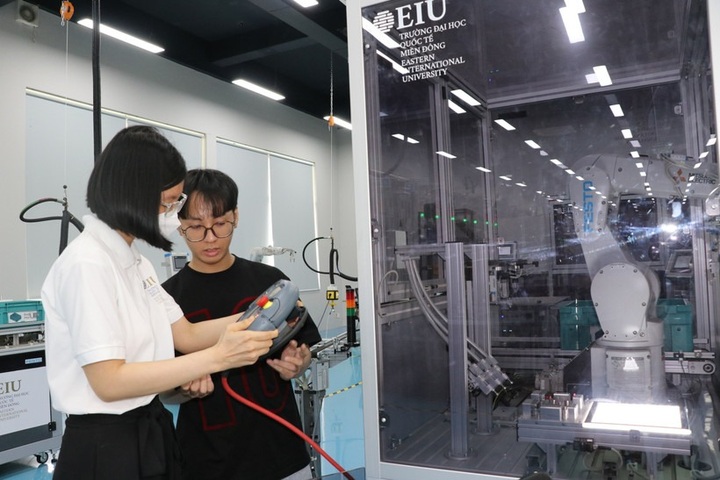
Eastern International University (EIU) introduces practical lessons on operating automation robots in conditions similar to those in factories, enabling students to be job-ready immediately after graduation. (Photo: VNA)
One of the most notable initiatives is the launch of the “Vietnam AI Academy”, expected to mark a breakthrough in developing internationally standardised AI talent and offering a fresh approach to workforce training in this field.
Strong demand, limited supply
Vietnam has identified AI as one of three pillars of its strategic technology pillars, alongside data and computing infrastructure. Central to mastering this field is the development of highly skilled human resources with the ability not only to absorb but also to innovate, apply, and disseminate knowledge.
In recent years, many universities have opened AI-related programmes and increased enrolment quotas. Around 150 universities and colleges nationwide now offer courses in information and communications technology (ICT), supported by some 74,000 technology firms – the main pool for digital and AI workforce training. Yet, training still falls short in both scale and quality compared with actual demand.
A Google report estimates Vietnam currently has only 300 AI experts, while the market faces an annual shortfall of 150,000–200,000 ICT workers, particularly in AI, big data, and cybersecurity.
Do Thanh Binh, Director of International Cooperation at the Vietnam Software and IT Services Association (VINASA), said demand for AI personnel is forecast to surge by 74 per cent during 2025–2030, requiring hundreds of thousands of new engineers each year.
Beyond numbers, quality remains a concern. Training at many universities remains heavy on theory, with limited practical application and little alignment with global trends such as deep learning and generative AI. Lecturers with hands-on project experience are concentrated in a few major institutions.
Assoc. Prof. Dr. Nguyen Van Vu of the University of Science under the Vietnam National University - Ho Chi Minh City, noted that business demand for AI talent grows by 10–25 per cent annually, but universities are only expanding enrolment by 5–10 per cent. He cautioned that without guaranteed training quality, new programmes might still leave graduates struggling to find job opportunities.
Infrastructure for AI research and teaching is also lacking, with limited high-performance computing systems and underdeveloped laboratories. Links between government, academia, and business remain largely formal rather than substantive.
A pioneering tri-sector model
In response, leading educational institutions are accelerating reforms. The Hanoi University of Science and Technology (HUST) has emerged as a frontrunner, leveraging its strong technical education tradition and research capacity. In partnership with NVIDIA and the National Innovation Centre (NIC), the university has launched the Vietnam AI Academy.
The initiative represents a pioneering collaboration between government, academia, and business, seen as a strategic approach to building a high-tech workforce. HUST Rector Huynh Quyet Thang said the academy aims to produce internationally qualified professionals and a strong AI expert network to support enterprises and localities in their digital transformation.
The academy plans to train at least 2,000 learners in its first year, rising to 6,000 in the second and 8,000–10,000 by the third. It also contributes to the ViGen Project, which is developing an open-source Vietnamese language dataset for AI research and application, with support from Meta, NIC, and the AI for Vietnam community.
Experts stress that building a high-quality AI workforce requires synchronised measures: updating curricula to international standards, upgrading lecturer capacity, investing in computing infrastructure, expanding research collaboration, and creating incentives to attract domestic and foreign specialists.
According to Vu Manh Cuong, Business Director of NVIDIA Vietnam, the country must urgently adopt the “train the trainer” model and combine self-learning with guided instruction. Training should target three levels: upskilling and reskilling existing ICT workers in public institutions, enterprises, and start-ups; standard training for average students; and advanced programmes for elite talent.
If pursued consistently, these efforts could help turn AI into a competitive advantage for Vietnam in the digital era, driving the country’s integration into the global value chain.




















